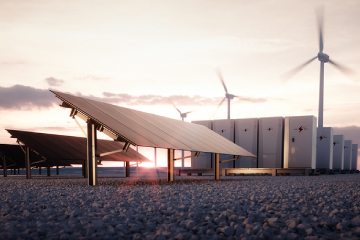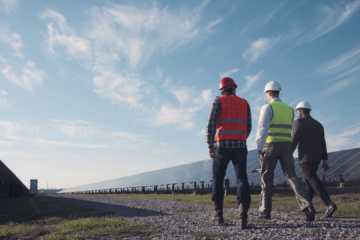- Why EDF power solutions?
- About UsAbout UsWe’re committed to providing future generations with the means to power their lives in the most economic, environmental and socially responsible ways possible.
- What We DoWhat We DoWe are a market-leading, independent power producer and service provider, delivering: wind (onshore and offshore), solar photovoltaic, storage, and electrical vehicle charging.
- Landowners
- Suppliers
- Projects
- Careers
- News
- Contact
Pillars of the Green Transition – Interview with Tristan Grimbert

Interview as featured in Newsweek Article “Pillars of the Green Transition” with Tristan Grimbert, President & Chief Executive Officer – EDF Renewables North America
You have an extensive background at EDF Renewables North America, how has the industry evolved in recent years and what is your focus for the near future?
The clean energy industry looks completely different than it did 17 years ago when I first started in this industry. At that time, renewables had a market penetration of only 1%. Today the market penetration is 20%. As the industry has evolved, so has our focus, by diversifying our offerings to meet the market’s needs. EDF Renewables has been dedicated for 35 + years to accelerating the energy transition through a holistic approach, growing our portfolio to include onshore and offshore wind, behind-the-meter, and in-front of the meter solar, microgrids, EV charging and green hydrogen among others. Energy from renewable sources has added the most megawatts in the US for the last 15 years. We are now working to understand how the Inflation Reduction Act (IRA) will be translated into practical guidance.
My focus for the near future is the grid and permitting improvements. The grid is outdated and requires significant updates to become a structure that allows for offshore wind projects to bring power to the mainland. Likewise, we have immense wind and solar resources in sparsely populated areas of Texas and the Great Plains, and we need to find the right methods to bring that power to the population centers. The IRA has not yet addressed energy transmission, but we hope that the promised permitting bill will help facilitate the permitting side, which is very important. We have the gigawatts, but we cannot currently support it with the current grid infrastructure.
Permitting is lagging, how do you see this landscape evolving and what are the key points you hope the government addresses with the IRA?
Becoming mainstream means expanding into areas that are not easy to permit, whether this is in terms of social acceptance or logistics. Our development skills are constantly tested; it is vital to permit projects in a way that is supported by the local population, while also being respectful of the environment. The US has a complex government organization between federal, states and local government bodies. Coordination amongst various permitting agencies is critical to success as well as the responsiveness and execution of the various agencies involved. The Biden administration has a great ambition to tackle this problem through the federal and state consultation process for offshore. This demonstrates that improvement is possible, and a lot remains to be done.
The IRA will accelerate the deployment of renewables and change the game. Power generation will come at a lower cost, and attention needs to shift towards solutions to manage so many gigawatts in a way that is compatible with the grid.
For example, most of the coast in California is protected, so offshore wind projects that are going to be developed there need to find creative ways to bring the energy to load centers.
How is EDF Renewables selecting projects to develop in North America as we move forward in the green energy transition?
I am a big supporter of the energy mix, and the end goal is to combine all types of low-carbon energy generation to decarbonize as fast as possible, with as low a cost as possible for the end users. Today, renewables represent the lowest-cost production of energy as penetration levels increase, but the cost of integration is starting to become a challenge. Medium-term storage and green hydrogen technologies are our focus for the near future as both will play a key role for renewable integration in the next few years. Costs are still prohibitive without subsidies, but the IRA allows for green hydrogen to become competitive, whether by replacing grey hydrogen or by creating a way to store energy.
Have you felt any particular challenges when it comes to the supply chain and how have you mitigated them?
Energy project development spans up to 15 years and operation over 40 years, therefore stability is highly important. It is true that during the past three years we were met with a lot of uncertainty. In fact, it started with the trade wars between the US and China in 2018 and since then we have gone through many challenges that were difficult to manage. Overall, we passed the period with little casualties, but the super interdependence of the world’s economies is no longer politically acceptable, not because of supply chain delays, but due to the fact that each superpower realized its dependency and wants to regain autonomy vis-a-vis its rivals. The decoupling is happening, and it is going to drive additional costs, such as the relocation of manufacturing to the United States. We would prefer to have a local supply chain because we know we can depend on it, and it is not exposed to tariff risks.
What are some of the goals you would like to achieve in the next two to three years?
Continuing our success in offshore wind; building up more of our supply chain within the US; as well as finding the right technologies to facilitate the integration of renewables into the grid more efficiently. Medium to long-term storage is a target we want to acquire, but we need help from the government to modernize the grid.
To read the full edition of Pillars of the Green Transition click here.
- © 2025 EDF power solutions North America North America
- Privacy Policy
- AB 1305 Disclosure
- TCFD Report
- EDF power solutions


